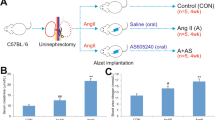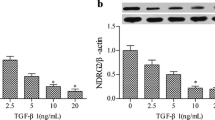Abstract
Renal fibrosis is a common characteristic of chronic kidney disease (CKD), and it can lead to end-stage renal disease. It has been reported that silibinin or lisinopril (MK-521) can inhibit the progression of renal fibrosis. However, the effect of combination of silibinin with MK-521 on renal fibrosis remains unclear. Therefore, this study aimed to explore the combination of silibinin with MK-521 on renal fibrosis in vitro and in vivo. The cell viability of HK-2 was detected by CCK-8. The gene and protein expression in HK-2 cells were detected by qRT-PCR and Western blot, respectively. Moreover, HFD-induced renal fibrosis mouse model was established to investigate the effect of silibinin in combination with MK-521 on renal fibrosis in vivo. The expressions of collagen I, α-SMA, Smad2 and Smad3 in TGF-β-treated HK-2 cells were notably decreased by MK-521, which was further inhibited in the presence of silibinin. In addition, we found that silibinin significantly enhanced anti-fibrotic effect of MK-521 on HFD-induced renal fibrosis mice. These findings demonstrated that silibinin could significantly increase anti-fibrotic effect of MK-521 in vitro and in vivo. Therefore, the combination of silibinin with MK-521 may serve as a potential strategy for the treatment of renal fibrosis.




Similar content being viewed by others
References
Hewitson TD. Renal tubulointerstitial fibrosis: common but never simple. Am J Physiol Renal Physiol. 2009;296:F1239–44.
Liu Y. Cellular and molecular mechanisms of renal fibrosis. Nat Rev Nephrol. 2011;7:684–96.
Santos-Paul MA, Neves RS, Gowdak LHW, et al. Cardiovascular risk reduction with periodontal treatment in patients on the waiting list for renal transplantation. Clin Transplant. 2019;4:e13658.
Jha V, Garcia-Garcia G, Iseki K, et al. Chronic kidney disease: global dimension and perspectives. Lancet. 2013;382:260–72.
Diwan V, Brown L, Gobe GC. Adenine-induced chronic kidney disease in rats. Nephrology (Carlton). 2018;23:5–11.
Jacobs ER, Narayanan J, Fish BL, et al. Cardiac remodeling and reversible pulmonary hypertension during pneumonitis in rats after 13-Gy partial-body irradiation with minimal bone marrow sparing: effect of lisinopril. Health Phys. 2019;116:558–65.
Cuevas CA, Tapia-Rojas C, Cespedes C, Inestrosa NC, Vio CP. Beta-catenin-dependent signaling pathway contributes to renal fibrosis in hypertensive rats. Biomed Res Int. 2015;2015:726012.
Asgharzadeh F, Hashemzehi M, Marjaneh RM, et al. Angiotensin-converting enzyme inhibitors and angiotensin receptor blockers as therapeuticoptions in the treatment of renal cancer: a meta-analysis. Life Sci. https://doi.org/10.1016/j.lfs.2019.117181
Bhatia N, Zhao J, Wolf DM, Agarwal R. Inhibition of human carcinoma cell growth and DNA synthesis by silibinin, an active constituent of milk thistle: comparison with silymarin. Cancer Lett. 1999;147:77–84.
Liu Y, Ye J, Cao Y, et al. Silibinin ameliorates diabetic nephropathy via improving diabetic condition in the mice. Eur J Pharmacol. 2019;845:24–31.
Li F, Ma Z, Guan Z, et al. Autophagy induction by silibinin positively contributes to its anti-metastatic capacity via AMPK/mTOR pathway in renal cell carcinoma. Int J Mol Sci. 2015;16:8415–29.
Liu K, Zhou S, Liu J, Wang Y, Zhu F, Liu M. Silibinin attenuates high-fat diet-induced renal fibrosis of diabetic nephropathy. Drug Des Dev Ther. 2019;13:3117–26.
Balys M, Dabek J, Glogowska-Ligus J, Gasior Z. Transcriptional activity of transforming growth factor beta 1 gene and its receptors in patients with early stages of coronary artery disease. Miner Med. 2019;110:92–4.
Meng XM, Zhang Y, Huang XR, Ren GL, Li J, Lan HY. Treatment of renal fibrosis by rebalancing TGF-beta/Smad signaling with the combination of asiatic acid and naringenin. Oncotarget. 2015;6:36984–97.
Munoz-Felix JM, Gonzalez-Nunez M, Martinez-Salgado C, Lopez-Novoa JM. TGF-beta/BMP proteins as therapeutic targets in renal fibrosis. Where have we arrived after 25 years of trials and tribulations? Pharmacol Ther. 2015;156:44–58.
Vega G, Alarcon S, San Martin R. The cellular and signalling alterations conducted by TGF-beta contributing to renal fibrosis. Cytokine. 2016;88:115–25.
Kou B, Liu W, Tang X, Kou Q. HMGA2 facilitates epithelial-mesenchymal transition in renal cell carcinoma by regulating the TGF-beta/Smad2 signaling pathway. Oncol Rep. 2018;39:101–8.
Sutariya B, Saraf M. Betanin, isolated from fruits of Opuntia elatior Mill attenuates renal fibrosis in diabetic rats through regulating oxidative stress and TGF-beta pathway. J Ethnopharmacol. 2017;198:432–43.
Tsai T, Kroehl ME, Smith SM, Thompson AM, Dai IY, Trinkley KE. Efficacy and safety of twice- vs once-daily dosing of lisinopril for hypertension. J Clin Hypertens (Greenwich). 2017;19:868–73.
Verdura S, Cuyas E, Llorach-Pares L, et al. Silibinin is a direct inhibitor of STAT3. Food Chem Toxicol. 2018;116:161–72.
Khazim K, Gorin Y, Cavaglieri RC, Abboud HE, Fanti P. The antioxidant silybin prevents high glucose-induced oxidative stress and podocyte injury in vitro and in vivo. Am J Physiol Renal Physiol. 2013;305:F691–700.
Wang XT, Sun XJ, Li C, et al. Establishing a cell-based high-content screening assay for TCM compounds with anti-renal fibrosis effects. Evid Based Complement Altern Med. 2018;2018:7942614.
Li H, Cai H, Deng J, et al. TGF-beta-mediated upregulation of Sox9 in fibroblast promotes renal fibrosis. Biochim Biophys Acta Mol Basis Dis. 2018;1864:520–32.
Higgins SP, Tang Y, Higgins CE, et al. TGF-beta1/p53 signaling in renal fibrogenesis. Cell Signal. 2018;43:1–10.
March JT, Golshirazi G, Cernisova V, et al. Targeting TGFbeta signaling to address fibrosis using antisense oligonucleotides. Biomedicines. 2018;6:74.
Branton MH, Kopp JB. TGF-beta and fibrosis. Microbes Infect. 1999;1:1349–65.
Cho JW, Il KJ, Lee KS. Downregulation of type I collagen expression in silibinin-treated human skin fibroblasts by blocking the activation of Smad2/3-dependent signaling pathways: potential therapeutic use in the chemoprevention of keloids. Int J Mol Med. 2013;31:1148–52.
Ai W, Zhang Y, Tang QZ, et al. Silibinin attenuates cardiac hypertrophy and fibrosis through blocking EGFR-dependent signaling. J Cell Biochem. 2010;110:1111–22.
Johnson FL, Patel NSA, Purvis GSD, et al. Inhibition of IkappaB kinase at 24 hours after acute kidney injury improves recovery of renal function and attenuates fibrosis. J Am Heart Assoc. 2017;6:e005092.
Huang J, Chen Z, Li J, et al. Protein kinase CK2alpha catalytic subunit ameliorates diabetic renal inflammatory fibrosis via NF-kappaB signaling pathway. Biochem Pharmacol. 2017;132:102–17.
Author information
Authors and Affiliations
Corresponding author
Ethics declarations
Conflict of interest
The authors declare no competing interests in this study.
Ethical statement
All in vivo experiments were performed in accordance with National Institutes of Health guide for the care and use of laboratory animals, following a protocol approved by the Ethics Committees of Liaocheng People’s Hospital.
Additional information
Publisher's Note
Springer Nature remains neutral with regard to jurisdictional claims in published maps and institutional affiliations.
Electronic supplementary material
Below is the link to the electronic supplementary material.
13577_2019_314_MOESM1_ESM.jpg
Supplementary material 1 Supplementary Figure 1 In vitro cell model of fibrosis was successfully established. (A) HK-2 cells were treated with 5 ng/ml TGF-β1 for 72 h. Then, expressions of collagen I, MMP9 and α-SMA in cells were measured by RT-qPCR. (B) The protein expressions of collagen I, MMP9 and α-SMA in HK-2 cells were examined by western blot. GAPDH was used as an internal control. The relative protein expression of (C) collagen I, (D) MMP9 and (E) α-SMA normalized to GAPDH was quantified. **P<0.01 vs. control group. Three independent experiments were performed (JPG 533 kb)
Rights and permissions
About this article
Cite this article
Ma, Z., Zang, W., Wang, H. et al. Silibinin enhances anti-renal fibrosis effect of MK-521 via downregulation of TGF-β signaling pathway. Human Cell 33, 330–336 (2020). https://doi.org/10.1007/s13577-019-00314-9
Received:
Accepted:
Published:
Issue Date:
DOI: https://doi.org/10.1007/s13577-019-00314-9




